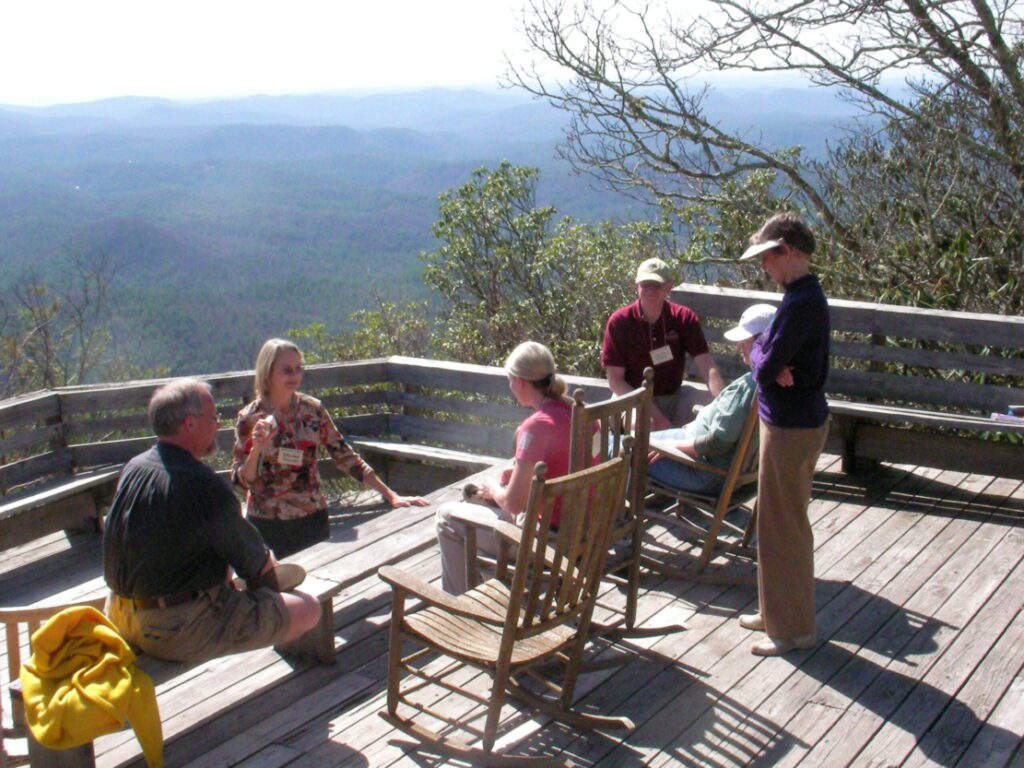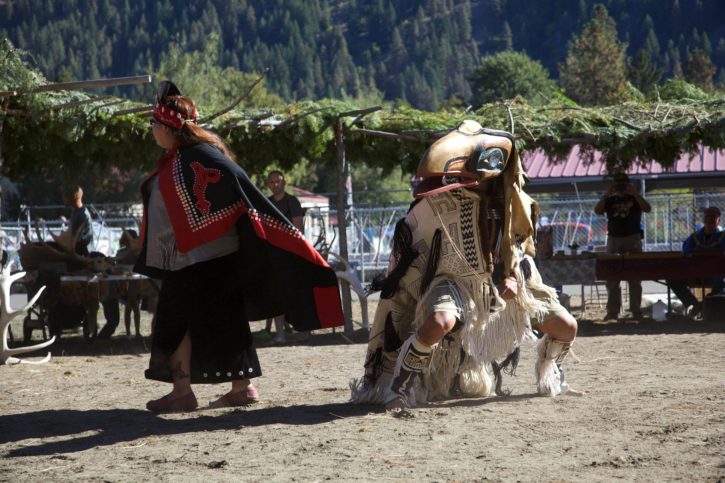“I went to the woods because I wished to live deliberately, to front only the essential facts of life, and see if I could not learn what it had to teach, and not, when I came to die, discover that I had not lived.”
– Henry David Thoreau, Walden
Most people enjoy spending time outdoors. The existence of state and national parks, public beaches, mountain resorts, and other outdoor recreational facilities can attest to this fact. We seek nature because it is not only enjoyable but healthy as well. A large and growing body of research demonstrates that nature is good for the mind as well as the body.
Not only is spending time in nature relaxing and healthy. It can also facilitate mindful states of being. Mindfulness is simply a way of paying attention to the moment in which you find yourself by focusing on your immediate experience rather than on ruminations and negative thought patterns (Carlson, et al 2004). These negative thinking cycles may be producing stress depression, or anxiety. By entering mindful states, we break these cycles. Scientific study continues to demonstrate that mindfulness increases attention and concentration, facilitates calmer states, and helps with stress reduction. Mindfulness works so well in this capacity that it has been referred to as the “penicillin of mental health.”
By re-integrating ourselves with nature through Mindfulness-Based Ecotherapy, we can tap into nature’s healing power and heal the earth as we heal ourselves.
Mindfulness-Based Ecotherapy is an integrative approach that combines principles and practices of mindfulness with the healing potential of nature. It involves engaging in mindfulness practices while immersed in natural environments, such as forests, parks, gardens, or wilderness settings. Mindfulness-Based Ecotherapy emphasizes cultivating present-moment awareness, non-judgmental observation, and connection with the natural world to promote mental, emotional, and physical well-being.
Key components of Mindfulness-Based Ecotherapy may include:
- Ecopsychology Principles: Mindfulness-Based Ecotherapy draws upon principles of ecopsychology, which recognizes the interconnection between human well-being and the health of the natural world. Participants may explore themes of ecological consciousness, environmental stewardship, and eco-spirituality in their therapeutic journey. By recognizing that we are ultimately a part of the environment and what we do to the environment we do to ourselves, we are eventually able to appreciate being a part of something larger than ourselves while also experiencing a sense of oneness with nature and the natural world.
- Nature Immersion: Participants immerse themselves in natural environments, engaging their senses to connect with the sights, sounds, smells, and textures of the natural world. Engaging the senses in this manner naturally facilitates a shift from doing mode to being mode. From being mode participants are able to be with thoughts and feelings without necessarily feeling the need to respond or react to them.
- Mindfulness Practices in Nature: Individuals engage in mindfulness meditation in natural settings, mindful walking in nature, or other mindfulness exercises with an element of nature to deepen their present-moment awareness and attunement to their inner experiences and external surroundings.
- Reflection and Contemplation in Nature: Participants reflect on their experiences in nature, exploring thoughts, emotions, and sensations with curiosity and acceptance. Contemplative practices, such as journaling, creative expression, or group sharing, may facilitate deeper insights and integration. Reflective and expressive types of eco art therapy like Sandtray Eco-Art Therapy (SEAT) may also be utilized to enhance these experiences (Figueroa, 2023).
- Embodied Presence: Mindfulness-Based Ecotherapy encourages embodied presence, grounding individuals in their bodies and the sensory experience of being in nature. Practices such as mindful movement, yoga, or somatic experiencing may help cultivate a deeper connection between mind, body, and environment. Through the tools and techniques of Wise mind and Wise Body, we are able to ground and center. Nature and ecotherapy help to facilitate this embodied presence.
- Integration and Application: Participants explore how insights gained from Mindfulness-Based Ecotherapy practices can be integrated into their daily lives, relationships, and broader ecological contexts. This may involve exploring sustainable lifestyle choices, environmental advocacy, or fostering a deeper sense of belonging and interconnectedness with the natural world. This is why many Mindfulness-Based Ecotherapy interventions contain a component of some sort of community involvement and/or advocacy. This principle is usually described as an attitude of gratitude or the cycle of nurture.
- Nature-Based Rituals and Ceremonies: Rituals, ceremonies, or symbolic gestures performed in natural settings may facilitate healing, transformation, and connection with the earth and its cycles. These rituals may draw inspiration from indigenous traditions, earth-based spirituality, or personal meaningful experiences. Mindfulness-Based Ecotherapy offers practitioners ample opportunities to create their own rites and rituals. From the perspective of Mindfulness-Based Ecotherapy, the only “correct” rites and rituals are the ones that have meaning to the individual.
Mindfulness-Based Ecotherapy offers a holistic approach to healing and self-discovery, integrating the restorative power of nature with the transformative potential of mindfulness practice. By fostering a deep sense of connection with the earth and one’s inner landscape, Mindfulness-Based Ecotherapy supports individuals in cultivating resilience, well-being, and ecological consciousness in an increasingly disconnected world.

Ecopsychology Principles in Mindfulness-Based Ecotherapy
By incorporating ecopsychological principles into daily life, individuals can cultivate a deeper connection with nature, leading to numerous benefits for mental, emotional, and physical well-being. Ecopsychology emphasizes the importance of reconnecting with nature to promote holistic well-being. Research by Bratman et al. (2019) highlights the restorative effects of spending time in natural environments, including reduced stress, improved mood, and enhanced cognitive function. By incorporating regular nature walks, outdoor activities, or simply spending time in green spaces, individuals can rejuvenate their mental and emotional states.
Ecopsychology encourages mindfulness and nature awareness as pathways to deeper ecological consciousness. Mindfulness practices, such as meditation and sensory awareness exercises in natural settings, facilitate a profound connection with the present moment and the natural world. A study by Nisbet et al. (2019) demonstrated that mindfulness interventions in nature led to increased feelings of connectedness to nature and reduced psychological distress among participants. By cultivating mindfulness in nature in daily life, individuals can develop a greater appreciation for the beauty and interconnectedness of all living beings.
Applying ecopsychology principles fosters ecological self-awareness, which involves recognizing one’s interconnectedness with the environment and other species. Research by Schultz et al. (2020) suggests that experiences of awe in nature promote feelings of interconnectedness and empathy towards the natural world. By immersing oneself in awe-inspiring natural landscapes, individuals can expand their sense of self to encompass the broader ecological community, leading to pro-environmental attitudes and behaviors.
This sense of oneness facilitates the process of living in True Self, enhancing self-esteem and self-awareness.
While ecopsychology is the study of how nature impacts mental and physical wellbeing, ecotherapy is the application of knowledge gained through ecopsychology in a therapeutic environment. Ecotherapy utilizes nature-based interventions to promote healing and personal growth.
Recent studies have demonstrated the efficacy of ecotherapy in treating various mental health conditions, such as depression, anxiety, and trauma. For example, a meta-analysis by Annerstedt and Währborg (2011) found that ecotherapy interventions produced significant improvements in psychological well-being and quality of life among participants. By incorporating ecotherapy techniques, such as nature-based mindfulness exercises, wilderness therapy, or horticultural therapy, Mindfulness-Based Ecotherapy can tap into nature’s healing power to address psychological challenges and enhance resilience.
By fostering a deep connection with nature, individuals are more likely to adopt eco-friendly behaviors and advocate for environmental conservation. Research by Otto et al. (2021) suggests that experiences of awe in nature inspire pro-environmental actions, such as reducing consumption, supporting renewable energy initiatives, and participating in conservation efforts.
From the perspective of Mindfulness-Based Ecotherapy, such awe-inspiring nature-based experiences foster spiritual connections. This sort of spiritual connection facilitated by nature is referred to as ecospirituality. By aligning personal values with ecological and personal spiritual principles, individuals can contribute to positive environmental change and create a more sustainable future for generations to come. This sense of connection to all of nature enhances an individual’s ability to live in True Self.
Integrating ecopsychology principles into daily life offers numerous benefits for individual well-being and environmental sustainability. By reconnecting with nature, cultivating mindfulness, fostering ecological self-awareness, and embracing ecotherapy techniques, individuals can enhance their mental, emotional, and physical health while fostering a deeper appreciation for the natural world.
Nature Immersion
Nature immersion, in conjunction with mindfulness practices, constitutes the core essence of Mindfulness-Based Ecotherapy. Within Mindfulness-Based Ecotherapy, various types of nature immersion serve as pathways for individuals to cultivate present-moment awareness, deepen their connection with the natural world, and promote holistic well-being. This section explores different types of nature immersion inherent in Mindfulness-Based Ecotherapy, elucidating and highlighting their significance and therapeutic benefits.
Some types of nature immersion that might be used in Mindfulness-Based Ecotherapy include:
- Sensory Immersion: Sensory immersion involves engaging all five senses, sight, sound, touch, smell, and taste, to fully experience the natural environment. Participants may close their eyes to listen to the rustle of leaves, feel the texture of tree bark, inhale the fragrance of wildflowers, or savor the taste of fresh air. By awakening the senses, sensory immersion heightens awareness and fosters a deeper connection with the present moment. This is because it is impossible to experience anything through the senses outside of the present moment, so focusing on the senses naturally facilitates present-moment awareness and living in the now.
- Embodied Immersion: Embodied immersion entails grounding oneself in the physical sensations of the body while in nature. Participants may practice mindful walking, feeling the earth beneath their feet with each step, or engage in yoga postures amidst natural surroundings, or other physical activities designed to enhance the wise mind/wise body experience. Through embodied presence, individuals cultivate a sense of integration with nature, aligning mind, body, and environment in a harmonious union.
- Cognitive Immersion: Cognitive immersion involves engaging in contemplative practices to explore one’s thoughts, emotions, and perceptions in relation to the natural world. Participants may reflect on ecological themes, such as interconnectedness, impermanence, or ecological stewardship, and contemplate their personal relationship with nature. Cognitive immersion fosters introspection and insight, inviting individuals to deepen their ecological consciousness and sense of belonging within the web of life. In Mindfulness-Based Ecotherapy we often use some type of eco-art therapy, such as Sandtray Eco-Art Therapy (SEAT) to facilitate this cognitive immersion.
- Spiritual Immersion: Spiritual immersion encompasses connecting with the sacred or transcendent dimensions of nature through rituals, ceremonies, or moments of awe and wonder. Participants may engage in nature-based rituals, such as offerings to the earth, or witness awe-inspiring natural phenomena, such as a radiant sunset or starlit sky. Spiritual immersion evokes feelings of reverence, gratitude, and interconnectedness, nurturing a sense of spiritual fulfillment and alignment with the greater cosmos. In Mindfulness-Based Ecotherapy we define “spiritual” as a sense of connection to something larger than oneself. This could mean connection to a higher power, connection to nature, connection to others, or connection to self.
- Social Immersion: Social immersion involves fostering connections with others and the natural world through shared experiences in nature. Participants may engage in group activities, such as nature walks, storytelling circles, or eco-art projects, to cultivate a sense of community and interconnectedness. Social immersion nurtures a collective sense of belonging and support, fostering mutual care and collaboration in co-creating transcendent healing spaces within nature.
Each type of nature immersion inherent in Mindfulness-Based Ecotherapy offers unique therapeutic benefits. Some of these benefits include:
- Per Menardo, et al (2022), sensory immersion promotes sensory awareness and relaxation, reducing stress and enhancing overall well-being.
- Embodied immersion fosters embodiment and somatic awareness, facilitating grounding, resilience, and self-regulation (Blake, 2022).
- Cognitive immersion cultivates ecological mindfulness and insight, fostering ecological consciousness and environmental stewardship (Albrecht, 2020).
- Spiritual immersion nurtures a sense of awe, reverence, and interconnectedness, fostering spiritual growth and existential fulfillment (McClarty, 2021).
- Social immersion fosters a sense of belonging and support, enhancing social connection, empathy, and collective resilience (Pritchard, et al, 2020).
The various types of nature immersion inherent in Mindfulness-Based Ecotherapy provide diverse pathways for individuals to deepen their connection with nature, foster holistic well-being, and cultivate ecological consciousness. By engaging in sensory, embodied, cognitive, spiritual, and social immersion practices, individuals embark on a transformative journey of self-discovery, healing, and ecological reconnection within the embrace of the natural world.
Mindfulness-Based Ecotherapy invites us to explore the depths of our relationship with nature, recognizing it as a source of profound healing, wisdom, and interconnectedness in our lives. This exploration should ultimately lead to participants being able to live more fully in their true selves.
Mindfulness Practices in Nature
Mindful meditation, rooted in Buddhist traditions, revolves around the cultivation of non-judgmental awareness of the present moment. In simple terms, it involves becoming aware of the present moment and living in the now by shifting from doing mode into being mode. This shift from doing mode into being mode is facilitated by moving from thinking mode into sensing mode by focusing on the senses in the present moment.
When practiced in natural settings, mindful meditation takes on a profound new dimension. Surrounded by the sights, sounds, and scents of nature, individuals may anchor their attention to the present moment, letting go of rumination and worries about the past or future. The rustle of leaves, the chirping of birds, and the gentle sway of trees serve as guides, leading practitioners into deeper states of mindfulness. Research suggests that meditating in nature can lower stress levels, reduce symptoms of anxiety and depression, and enhance overall psychological well-being (Pascoe, et al, 2021).
Mindful walking, or walking meditation, is another core practice in mindfulness. When integrating movement with awareness, individuals engage in a slow, deliberate pace, paying attention to the sensations of each step and the shifting landscape around them. In natural settings, mindful walking becomes a sensory experience as participants attune themselves to the textures beneath their feet, the play of light and shadow, the aromas that surround them, and the symphony of nature’s sounds.
This embodied mindful experience fosters a sense of groundedness and interconnectedness with the earth and with all living things, facilitating profound moments of insight and tranquility. Moreover, studies have shown that mindful walking in nature can improve cognitive function, boost mood, and enhance overall physical well-being (Ma, et al, 2023).

Beyond meditation and mindful walking, various mindfulness exercises can incorporate elements of nature to deepen the therapeutic experience. For example, practitioners may engage in mindful breathing exercises while inhaling the crisp air of a mountain summit or practice an attitude of gratitude meditation while basking in the warmth of the sun on a sandy beach.
By infusing mindfulness practices with the richness of the natural world, individuals cultivate a profound sense of awe, reverence, and interconnectedness with all living beings. This eco-centric approach not only nourishes the spirit but also fosters a deeper commitment to environmental stewardship and sustainability, facilitating a connection to nature, to others, and to self.
Mindful practices in nature offer individuals a pathway to inner healing and environmental consciousness. By immersing themselves in natural settings, engaging in mindfulness practices, and fostering a deep attunement to the present moment by living in the now, practitioners can cultivate resilience, reduce psychological distress, and enhance their overall quality of life (Chandelkar, et al, 2024).
Reflection and Contemplation in Nature
Research in environmental psychology has consistently demonstrated the restorative effects of nature on mental well-being. In 1989, Kaplan and Kaplan’s Attention Restoration Theory (ART) posited that natural environments possess characteristics that effortlessly capture attention, allowing for attention restoration and mental rejuvenation. According to the Attention Restoration Theory, nature offers a respite from the demands of modern life, fostering a state of relaxation and psychological restoration.
Reflection and contemplation in natural settings amplify the therapeutic benefits of nature by providing practitioners with an opportunity for introspection and self-discovery. By immersing oneself in the sights, sounds, and textures of the natural world, individuals are encouraged to turn inward and explore their own inner landscapes. This process involves reflecting on past experiences, examining current thoughts and emotions, and contemplating future aspirations. Nature facilitates these contemplative practices.
Studies have shown that engaging in reflective practices in nature can lead to significant improvements in mood, self-awareness, and overall psychological well-being. A study by Bratman et al. (2015) found that participants who engaged in a 90-minute nature walk reported reduced rumination and decreased activity in the brain regions associated with brooding self-referential thoughts. Participants demonstrated increased neural activity in regions associated with attention and positive affect, suggesting a shift towards a more present-focused and positive mindset.
Contemplation and reflection in nature fosters a sense of connection with the natural world, leading to feelings of awe, gratitude, and humility. Research by Shiota et al. (2007) suggests that experiencing awe in nature can broaden one’s sense of perspective, leading to enhanced feelings of interconnectedness and prosocial behavior. By cultivating a sense of reverence for the natural world, individuals are better equipped to navigate life’s challenges with resilience and compassion.
Central to the practice of reflection and contemplation in nature is the cultivation of acceptance and mindfulness. Rather than resisting or suppressing their thoughts and emotions, participants are encouraged to observe them with curiosity and non-judgmental awareness. This type of reflection and contemplation in nature allows participants to accept the things they cannot change while gaining the wisdom to change the things they can. Mindfulness-based interventions, such as mindfulness meditation and nature-based therapy, have been shown to reduce symptoms of anxiety, depression, and stress (Ünsal & Korkmaz, 2023).
By integrating mindfulness practices into their interactions with nature, individuals can deepen their connection to the present moment and develop a greater sense of acceptance towards themselves and their surroundings. Research by Creswell et al. (2016) suggests that mindfulness training enhances self-regulation processes, leading to improved emotional regulation and stress resilience.
Reflection and contemplation in nature offer a powerful pathway toward self-discovery, healing, and personal growth. Individuals can gain valuable insights into their thoughts, emotions, and behaviors by immersing themselves in the beauty and tranquility of the natural world. Through acceptance and mindfulness, they can cultivate a deeper sense of connection with themselves, others, and the environment.
Embodied Presence in Nature
Embodied presence involves inhabiting one’s body fully and engaging with the present moment without judgment or distraction. In Mindfulness-Based Ecotherapy embodied presence is represented by the skills of wise mind and wise body.
In the context of ecotherapy, embodied presence extends to the sensory experience of being in nature, where individuals are encouraged to attune to the sights, sounds, smells, and textures of their natural surroundings. Research by Craig et al. (2020) suggests that embodied mindfulness practices promote greater awareness of bodily sensations and emotional states, leading to increased feelings of vitality and well-being.
Mindfulness-Based Ecotherapy grounds individuals in their bodies, facilitating a deep sense of connection with the physical world. The Mindfulness-Based Ecotherapy skill of centering teaches participants the skill of embodied presence through connecting with their True Selves in a natural environment.
Mindfulness-based interventions, such as body scan exercises and mindful movement practices such as outdoor yoga, Tai Chi, Qi Gong, or other types of slow, rhythmic movement, encourage individuals to pay attention to bodily sensations and movements with curiosity and acceptance. A study by Kerrigan et al. (2019) demonstrated that nature-based mindfulness practices led to improvements in body awareness and self-compassion among participants, enhancing their overall well-being.
Engaging the senses in nature is a central aspect of Mindfulness-Based Ecotherapy, allowing individuals to experience the richness and beauty of the natural world on a sensory level. Focusing on the senses in a natural environment leads to living in the now. This present-moment awareness is conducive to developing a sense of embodied presence.
Research by Marselle et al. (2019) indicates that sensory experiences in nature promote feelings of connection, awe, and deep emotional restoration. By immersing themselves in the sights, sounds, and smells of nature, individuals can deepen their appreciation for the interconnectedness of all living beings and foster a sense of belonging to the Earth community. This total sensory immersion is naturally conducive to living in the present moment.
Mindfulness-Based Ecotherapy enhances the mind-body connection by integrating mindfulness practices with physical movement and sensory awareness in nature. Research by Zelinski et al. (2021) suggests that nature-based mindfulness interventions improve somatic awareness and emotional regulation, leading to reduced symptoms of stress and anxiety. By fostering a harmonious relationship between mind and body, individuals can experience a profound sense of wholeness and vitality that is embodied presence in nature.
The therapeutic benefits of embodied presence through Mindfulness-Based Ecotherapy are manifold, encompassing improved mental, emotional, and physical well-being. Studies have shown that engaging in mindful practices in nature reduces symptoms of depression, anxiety, and trauma, while also enhancing resilience and self-compassion. Research by Staempfli et al. (2020) suggests that Mindfulness-Based Ecotherapy interventions lead to significant improvements in mood and overall quality of life among participants.
The Mindfulness-Based Ecotherapy skills of wise mind and wise body offer a transformative pathway for individuals to cultivate embodied presence and deepen their connection with nature. By grounding individuals in their bodies and the sensory experience of being in nature, Mindfulness-Based Ecotherapy facilitates a profound sense of interconnectedness and well-being. This is the essence of embodied presence.

Integration and Application of Mindfulness-Based Ecotherapy
Mindfulness-Based Ecotherapy offers practitioners a transformative pathway to deepen their connection with nature and cultivate holistic well-being. Beyond the therapeutic setting, participants are encouraged to integrate the insights gained from Mindfulness-Based Ecotherapy practices into their daily lives, relationships, and broader ecological contexts. This integration and application of Mindfulness-Based Ecotherapy principles helps individuals to enhance their own transformative potential.
Mindfulness-Based Ecotherapy combines mindfulness techniques with engagement in nature, fostering a deeper connection with the natural world and one’s inner landscape. Participants learn to cultivate present-moment awareness, sensory attunement, and ecological consciousness through guided meditation, nature walks, and reflective practices. Research by Bratman et al. (2019) suggests that engaging in Mindfulness-Based Ecotherapy practices leads to improved mood, reduced stress, and enhanced well-being.
The insights gained from Mindfulness-Based Ecotherapy practices can be integrated into various aspects of daily life to promote balance, resilience, and sustainability. Participants learn to bring mindfulness and presence into everyday activities, such as eating, walking, and interacting with others. Studies by Brown and Kasser (2019) have shown that incorporating mindfulness into daily routines leads to greater satisfaction, meaning, and connection with oneself and others.
Mindfulness-Based Ecotherapy practices can deepen interpersonal connections and foster compassionate communication within relationships. Participants learn to listen deeply, empathize with others, and cultivate a sense of interconnectedness with all living beings. Research by Schutte et al. (2020) suggests that mindfulness-based interventions improve relationship satisfaction, conflict resolution skills, and emotional intimacy among couples and families.
In many interventions, participants explore how insights from Mindfulness-Based Ecotherapy practices can inform their engagement with ecological issues and inspire pro-environmental action. By cultivating a sense of interconnectedness and stewardship towards the Earth, individuals are motivated to advocate for environmental conservation, sustainable living practices, and social justice. Studies by Otto et al. (2021) indicate that experiences of awe in nature inspire pro-environmental behaviors and support for conservation initiatives. This creates a synergistic effect. Caring for the environment enhances awe-inspiring moments in nature, and awe-inspiring moments in nature encourage caring for the environment.
Mindfulness-Based Ecotherapy often encourages participants to connect with like-minded individuals and engage in collective efforts to protect and restore the natural world. By fostering a sense of community and shared purpose, individuals can amplify their impact and create meaningful change on a larger scale. Research by Staempfli et al. (2020) suggests that group-based mindfulness interventions lead to increased social connectedness and collective well-being among participants. The effects of such group-based mindfulness interventions are enhanced through outdoor spaces and experiences in the natural environment.
The integration and application of Mindfulness-Based Ecotherapy practices offer a pathway for individuals to cultivate resilience, connection, and ecological consciousness in their daily lives and the broader circles of their families, their friends, their loved ones, and the environments in which they all live. By incorporating Mindfulness-Based Ecotherapy into daily routines, practitioners are empowered to enhance interpersonal relationships, engage in ecological activism, and participate in community-based initiatives. By integrating and applying Mindfulness-Based Ecotherapy, individuals can contribute to a more sustainable and compassionate world while increasing their own ability to live in their true selves.
Nature-Based Rituals and Ceremonies
Nature has long been a source of inspiration and reverence for humanity, providing solace, wisdom, and healing. Across cultures and civilizations, rituals, ceremonies, and symbolic gestures performed in natural settings have played a significant role in fostering connection with the Earth and its cycles. Nature-based rituals and ceremonies can have a profound impact on healing, transformation, and the cultivation of a deeper connection with the natural world.
Rituals conducted in natural settings hold a special significance, as they allow individuals to engage with the elemental forces of the Earth in a deeply symbolic and experiential manner. These rituals often draw upon the rhythms and cycles of nature, honoring the changing seasons, celestial events, and natural landscapes. In Mindfulness-Based Ecotherapy we consider a rite or a ritual to be an outward and visible sign of an inner emotional or cognitive state. In this way, rites and rituals can be profound metaphors for inner emotional and cognitive processes. Research by Berkes (2018) emphasizes the importance of rituals in reconnecting individuals with the ecological knowledge and wisdom embedded in traditional cultures.
Nature-based rituals facilitate healing and transformation by providing a sacred space for individuals to express their intentions, emotions, and aspirations. Symbolic gestures, such as offerings, prayers, or meditative practices, imbue everyday actions with deeper meaning and significance. Studies by Pálsdóttir et al. (2020) suggest that participating in nature-based ceremonies can promote emotional healing, resilience, and a sense of belonging within the Earth community.
Nature-based rites, rituals, and ceremonies foster a profound connection with the Earth and its cycles, allowing individuals to attune to the rhythms of the natural world. By aligning their ceremonies with seasonal changes, lunar phases, and planetary movements, participants deepen their awareness of the interconnectedness and interdependence of all living beings. Research by Fernández-Llamazares et al. (2017) highlights the role of nature-based rituals in fostering ecological consciousness and promoting sustainable behaviors.
Nature-based rituals serve as catalysts for personal and collective transformation, facilitating growth, healing, and spiritual evolution. Through intentional ceremony, individuals can release old patterns of behavior, old beliefs that are no longer productive, and past traumas, while embracing new possibilities and potentials. A study by Corazon et al. (2019) found that participating in nature-based rituals led to significant improvements in participants’ sense of well-being, purpose, and connection with nature.
Many nature-based rituals are rooted in indigenous traditions and wisdom, passed down through generations as sacred teachings. These rituals honor the land, ancestors, and spirits of place, serving as a bridge between past and future generations. Research by Kral (2021) underscores the importance of preserving indigenous knowledge and practices, recognizing their vital role in sustaining biodiversity, cultural diversity, and spiritual resilience.
Nature-based rituals, ceremonies, and symbolic gestures performed in natural settings hold immense potential for healing, transformation, and connection with the Earth and its cycles. By honoring the wisdom of indigenous traditions, engaging with the symbolism of the natural world, and participating in intentional ceremonies, individuals can cultivate a deeper sense of belonging and reciprocity within the web of life. Doing so helps foster connections with nature, others, and self, thereby enhancing one’s ability to live in true self.
Cultural Appropriation and Mindfulness-Based Ecotherapy
Colonialism and its effects have led to increased sensitivity to the possibility of cultural appropriation when it comes to engaging in nature-based forms of spirituality or celebration. As interest in nature-based spirituality and rituals grows, there is a pressing need to address the issue of cultural appropriation within these practices.
Many contemporary nature-based rites and rituals similar to those practiced in Mindfulness-Based Ecotherapy draw inspiration from indigenous traditions around the world. These traditional aboriginal practices are often misappropriated without proper acknowledgment or understanding of their cultural significance.
Cultural appropriation occurs when elements of one culture are adopted or used by members of another culture without proper understanding, recognition, or permission from the originating culture. In the context of nature-based forms of therapy and spirituality like those inherent in Mindfulness-Based Ecotherapy, cultural appropriation often manifests as the misappropriation of indigenous rituals, symbols, and practices without regard for their cultural context or significance. This cultural appropriation perpetuates colonialist attitudes and erases the contributions and wisdom of indigenous peoples.
In the absence of native European traditions, many practitioners of nature-based spirituality have turned to indigenous cultures for inspiration and guidance. However, this appropriation of indigenous practices can lead to the commodification and trivialization of sacred traditions, as well as the perpetuation of harmful stereotypes and misconceptions. Moreover, it further marginalizes and erases the rich heritage of native European cultures that have been suppressed by centuries of Judeo-Christian colonization and cultural assimilation.
For those whose ancestors were of white European descent, where indigenous traditions have been marginalized and suppressed through Judeo-Christian forms of colonization, there is a unique challenge of reclaiming and honoring native European rites and rituals while avoiding cultural appropriation.
To recapture lost native European rites and rituals, it is essential to approach this process with humility, respect, and a commitment to cultural sensitivity. Rather than appropriating elements from other cultures, practitioners can draw inspiration from historical sources, folklore, and archaeological evidence to reconstruct and revitalize indigenous European traditions. This process requires extensive research, consultation with cultural experts, and a willingness to acknowledge and address historical injustices.
In recapturing native European rites and rituals, it is crucial to engage with indigenous communities and respect their perspectives, experiences, and sovereignty. Indigenous voices should be prioritized and empowered in discussions surrounding cultural revitalization and decolonization efforts. By centering the perspectives and priorities of indigenous peoples, practitioners can ensure that their efforts are grounded in authenticity, reciprocity, and respect for cultural diversity.
Rather than appropriating indigenous aboriginal practices, practitioners of forms of nature-based spirituality and therapy like Mindfulness-Based Ecotherapy can engage in meaningful cultural exchange and collaboration with indigenous communities. This involves fostering mutual respect, understanding, and solidarity across cultural boundaries. By building respectful relationships and partnerships with indigenous peoples, practitioners can honor their traditions while also contributing to cultural revitalization and reconciliation efforts.
Addressing cultural appropriation in Mindfulness-Based Ecotherapy requires a nuanced understanding of historical context, power dynamics, and cultural sensitivity. Recapturing lost native European rites and rituals offers an opportunity to reclaim and honor indigenous heritage while avoiding the pitfalls of appropriation. By approaching this process with humility, respect, and a commitment to collaboration, practitioners can foster a more inclusive, ethical, and authentic approach to nature-based spirituality that honors the diversity and complexity of human culture.
The interventions and activities most often used in Mindfulness-Based Ecotherapy and suggested in this textbook have been scrutinized for potential cultural appropriation and wherever applicable we have modified the activities to eliminate the potential for damage. When creating your own Mindfulness-Based Ecotherapy interventions, take care to ensure that the activities remain culturally sensitive to the First Nations across the world.

An Introduction to Mindfulness-Based Ecotherapy: Summary
This chapter began with the foundational principles and practices of Mindfulness-Based Ecotherapy (MBE), by exploring how mindfulness and nature are integrated to promote healing and well-being. We covered the theoretical underpinnings, practical applications, and ethical considerations, providing a comprehensive overview of how MBE can be implemented effectively and sensitively in various therapeutic contexts.
MBE is deeply rooted in ecopsychology, which emphasizes the intrinsic connection between human well-being and the natural environment. Ecotherapy posits that our mental health is intricately linked to the health of the ecosystem, advocating for a reconnection with nature to restore ecological identity and promote psychological healing.
Ecopsychology supports holistic approaches that consider individuals within the context of their broader ecological systems, fostering a sense of belonging and purpose. Nature immersion involves deeply engaging with natural environments, allowing the sights, sounds, and sensations of nature to soothe and rejuvenate the mind and body. Activities such as forest bathing, hiking, or spending extended time in natural settings are used to enhance sensory awareness and promote a sense of calm and connectedness.
Research shows that nature immersion can reduce stress, improve mood, and enhance cognitive function, supporting the therapeutic goals of MBE by leveraging the restorative effects of natural environments. Mindfulness in nature involves practices that heighten awareness of the present moment through focused attention to natural surroundings. Techniques include mindful walking, observing natural elements, and engaging all senses to fully experience the environment.
Mindfulness practices often incorporate breath awareness and body scanning exercises, encouraging participants to synchronize their breath with the rhythms of nature and deepen their connection to their physical presence. MBE encourages reflective practices in nature, such as journaling, meditative reflection, or silent contemplation, to facilitate introspection and personal growth. These practices allow individuals to explore their inner landscapes and find meaning and insight through their interaction with the natural world.
By creating space for quiet reflection, MBE helps clients process their thoughts and emotions, fostering greater self-awareness and emotional clarity. Embodied presence emphasizes the integration of body awareness with environmental engagement, fostering a deep sense of being grounded and present in the moment. Practices such as mindful movement, yoga in nature, or grounding exercises help clients attune to their bodily sensations and the natural surroundings. This approach strengthens the mind-body connection, promoting physical relaxation, emotional balance, and a deeper sense of harmony with nature.
MBE interventions are tailored to the needs and preferences of individuals or groups, allowing for flexible and adaptive applications across different therapeutic settings. Integration can include combining MBE with traditional therapeutic modalities or designing customized nature-based activities that align with clients’ therapeutic goals. The collaborative and experiential nature of MBE fosters a strong therapeutic alliance, as clients and therapists engage together in the healing process facilitated by the natural environment.
Rituals and ceremonies in nature, such as seasonal celebrations, gratitude practices, or symbolic acts of letting go, provide structured opportunities for individuals to connect deeply with themselves and the environment. These practices can mark transitions, celebrate milestones, or facilitate healing and transformation. It is essential to approach nature-based rituals with cultural sensitivity and respect, ensuring that practices are inclusive and honor diverse traditions and beliefs. Practitioners of MBE must be vigilant about cultural appropriation, particularly when incorporating elements from indigenous traditions or other cultural practices into therapeutic interventions. Respect for the origins of these practices and collaboration with cultural bearers is crucial to avoid misappropriation and to honor the integrity of the traditions. Ensuring that MBE practices are accessible and inclusive to all individuals, regardless of cultural background, is vital for fostering a respectful and ethical therapeutic environment.
This chapter provided an introductory exploration into Mindfulness-Based Ecotherapy, highlighting its unique integration of mindfulness and nature to foster holistic healing. By grounding its practices in ecopsychology and emphasizing nature immersion, reflection, and embodied presence, MBE offers powerful tools for promoting well-being and ecological connection. However, the practice must be approached with sensitivity to cultural appropriation and ethical considerations. As the field grows, continuing to build a strong evidence base and ensuring inclusive and respectful practices will be essential for the future development of MBE.


